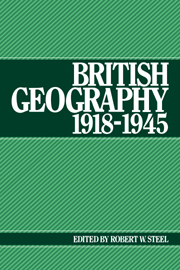Book contents
- Frontmatter
- Contents
- Preface
- 1 The beginning and the end
- 2 Geography during the inter-war years
- 3 Geography in the University of Wales, 1918–1948
- 4 Geography at Birkbeck College, University of London, with particular reference to J. F. Unstead and E. G. R. Taylor
- 5 The Oxford School of Geography
- 6 Geography in the Joint School (London School of Economics and King's College)
- 7 Geography in a University College (Nottingham)
- 8 Geographers and their involvement in planning
- 9 On the writing of historical geography, 1918–1945
- 10 Physical geography in the universities, 1918–1945
- 11 Geographers and geomorphology in Britain between the wars
- 12 British geography, 1918–1945: a personal perspective
- Index
1 - The beginning and the end
Published online by Cambridge University Press: 07 October 2009
- Frontmatter
- Contents
- Preface
- 1 The beginning and the end
- 2 Geography during the inter-war years
- 3 Geography in the University of Wales, 1918–1948
- 4 Geography at Birkbeck College, University of London, with particular reference to J. F. Unstead and E. G. R. Taylor
- 5 The Oxford School of Geography
- 6 Geography in the Joint School (London School of Economics and King's College)
- 7 Geography in a University College (Nottingham)
- 8 Geographers and their involvement in planning
- 9 On the writing of historical geography, 1918–1945
- 10 Physical geography in the universities, 1918–1945
- 11 Geographers and geomorphology in Britain between the wars
- 12 British geography, 1918–1945: a personal perspective
- Index
Summary
To understand the progress of geography in Britain between 1918 and 1945 it is important to appreciate what was the state of the subject at the beginning and at the end of the period under review. However ‘new’ geography may sometime seem to us in the twentieth century, certainly as a university discipline, it is a subject with a long and honourable history. Its evolution over the centuries has been studied by many writers, both in general terms and in detail, and it is unnecessary to repeat this story even in summary form. Perhaps it is enough to remind ourselves that geography has long been known and practised in Britain. We know, for example, that as long ago as 1187, Giraldus Cambrensis, a Welsh scholar in Oxford, read aloud his Topography of Ireland for three whole days in 1187. Nearly four hundred years later, and again in Oxford, Richard Hakluyt, a Student of Christ Church, gave lectures on geography and subsequently produced the series of volumes called The Principall navigations, voyages and discoveries of the English nation. Indeed the view of J. N. L. Baker is that the progress of academic geography in Britain during ‘the seventeenth and eighteenth centuries is largely concerned with the University of Oxford which during that period led the way in geographical study and accomplishment, and produced one work of outstanding merit’ (Nathanael Carpenter's Geographie Delineated Forth in Two Bookes, containing the Sphaericall and Topicall Parts thereof, published in Oxford in 1625).
- Type
- Chapter
- Information
- British Geography 1918–1945 , pp. 1 - 8Publisher: Cambridge University PressPrint publication year: 1987
- 1
- Cited by



